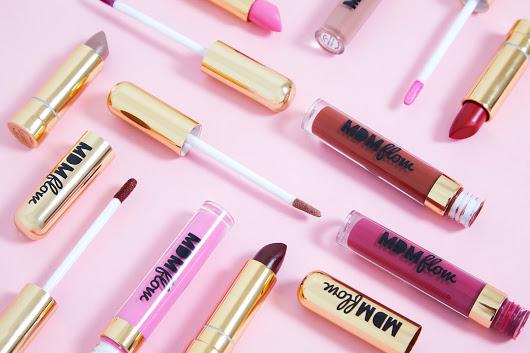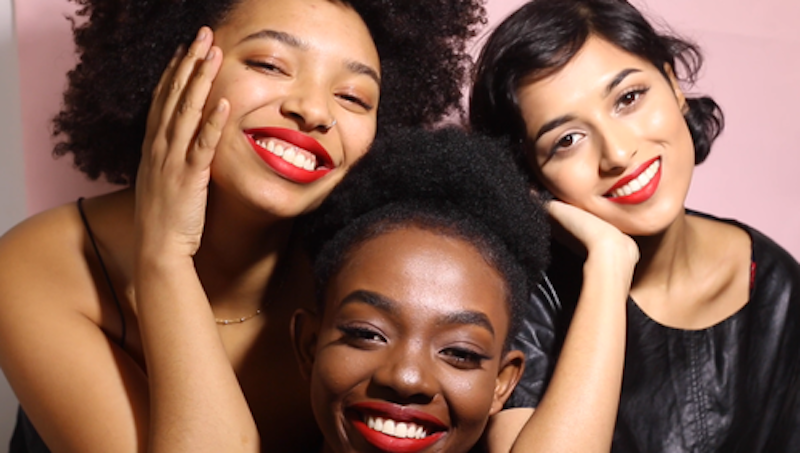Florence Adepoju is the CEO and founder of MDMflow, a vegan and cruelty-free British beauty brand that includes women of color. MDMflow’s products range from traditional and liquid lipstick to mascara and lip balm.
Adepoju graduated from the London College of Fashion in 2013 and shortly after founded her makeup company with £10,000. Florence first worked out of her parents’ shed in Essex, England, and began making products out of the lab she set up at home. In 2015 the company gained international recognition after the New York Times wrote a feature. “I used to sell my products out to loads of journalists and Oxford Reviews and I would request their feedback…In December 2015 we had a feature in the New York Times…It went from the business being very small to just getting big, literally overnight,” she says.
I had the pleasure of meeting Adepoju — using zoom of course and she dialed into our meeting room from her parent’s house in Essex, England. Over spotty wifi and some green tea, we talked about makeup, Nigerian aunties, and inclusion.
Why did you start this company?
I had just graduated from studying cosmetic science at the London College of Fashion and was working on a makeup counter. I felt that the beauty industry didn’t really allow women – women of color and black women – to express themselves when it came to beauty. A lot of that issue came from the formulas and how things were made. Being fresh from studying, I knew that the technology and information were out there to create greater formulas but brands were not paying attention to the wider consumer groups.
Outside of the formulas, brands weren’t paying attention to influences concerning color and style. Beauty has changed a lot, but back then everything was very demure, classic glamour and soft, whereas I felt that the beauty I was into reflected more of my background. I’m from Nigeria and I’m used to weddings and aunties with the black lip liner and the purple or bright red lipstick, just color! A lot of my inspiration was from wanting to express culture through the product range and through my collection.
Tell me about your experience studying cosmetic science at the London College of Fashion.
It was really interesting and I really enjoyed it. The college is in the center of London, and we had mostly Asian students. It wasn’t your traditional uni context, it felt like an office because of where it was based and I think that really prepared me for the work mindset. I used to work at loads of different department stores on Oxford Street, so I got so much exposure to people and brands from all around the world. I really loved that and it helped influence me in the business that I built, it also helped empower me in thinking and feeling, “Okay, I can do this.”
What ingredients do you use in your products?
Pretty much all our ingredients are made from natural oils and waxes to form the base of the lipsticks. We also use iron oxides, which are natural mineral pigments to do the coloring [in our lipsticks] and it’s basically a two-part process. Over the years I’ve added some really cool cultural factors, like in my balms we have Shea butter which I love. We also have a butter named Murmur which is Brazilian nut butter. I think people are used to color cosmetics being low quality and I want to show that you can have a really high-quality, nourishing product that is still bright red or pink.

Where do you source your ingredients from?
I mostly use European suppliers just because a lot of them are already credited at doing all the stringent testing within the cosmetics industry. Some of my ingredients, like the oils and butters are from Africa but the pigments are mostly from Asia.
How do you test your products?
We do microbial testing, we also test how our products perform at different levels of heat. We do performance testing too which is mostly done through consumer trials either by my customers or through my team and we don’t do any testing on animals.
What does a sustainable makeup brand mean to you and how does MDMflow fit into that definition?
I feel like it’s about creating the standard. I’m massively inspired by Anita Roddick who was the founder of The Body Shop because I feel like she created a new standard in beauty, she’s the reason why so many brands use natural components. Early on in her story, she was a very small shop, and then she got acquired by L’Oreal, which is the biggest beauty company in the world. Certain changes were then made to their supply chain through that process. I think the beauty industry now is very segmented, but I feel like if you have a brand that stands by values and ethics, you create a wave through the industry that changes the standard. As an industry that is worth billions, it has a direct impact on individual people’s lives, whether it be through the supply chain, or through the consumer group.
Do you think there is a fundamental shift within the makeup and beauty industry to adopt sustainable business practices?
I think there are amongst startup brands but it’s a difficult thing because collectively these brands make up such a small fraction of the industry. I feel like it’s going to be a long time before we see the majority of the industry working in an ecological way, but I think the good thing is small brands can grow quickly. Also online there’s a certain amount of clearness that you have to have with consumers.
With the bigger brands, people are asking them, “Are you testing on animals? Where are your materials from? What factories are your products made from?” Asking these important questions does lay pressure on brands and puts pressure on the industry. It has for the longest time just been about money and the margins associated with the industry. I think trying to change behaviors that impact people’s pockets can be a very long and hard thing. So I do believe it’s a case of smaller brands growing and knocking out the incumbents and setting a new standard.
Related Articles: How Sustainable is Green Beauty | Re – imagining Holiday Habits
How old were you when you started wearing makeup?
I would say about 13 — with the disapproval of my parents.
Did you have trouble finding shades that fit your skin tone?
Oh sure.
How did that impact you as a young girl?
So when I was 13, I used to only wear glittery eyeshadow and lip gloss. When I was about 16 I used to go to the local drugstore and I would look at the choices and there was nothing but 50 shades of beige, there was nothing usable. It was a sinking feeling because you lose a part of your adolescent experience. I’d see all these white girls running around and trying on makeup and feeling good and it just makes you feel invisible. At that age, you are not able to contextualize that there is a bigger industry problem so it just makes you internalize it, which isn’t healthy at such a young age.
How did that internalization impact your evolution into a young woman?
It was interesting because as a teenager I was very bold and confident. I think the industry being this way meant that when I started working, I already knew it wasn’t good enough. I always had this feeling of “I’m not okay with this and this needs to change.” In a weird way, it radicalized me when it came to the industry, and I was influenced by this feeling of dissatisfaction.
When we talk about diversity and representation within the British beauty industry, how big of a problem do you think that is today?
I think it’s huge. There’s a lot of black owned and diverse brands here, but they don’t get the same kind of trading and platforms as other brands which is very unhelpful. I think it’s so subtle because British beauty buyers aren’t normally from Black or ethnic minority backgrounds. There isn’t much diversity amongst buyers which means the stores don’t cater to diverse skin tones. I think what is really inspiring is seeing the growth of brands in the States who have built their own communities. That’s something that I’m focused on more at the moment, instead of trying to work within and change the British beauty industry.

How can the public, your customer base, and the beauty industry at large work together towards becoming ecological and inclusive?
I think for consumers, keep doing what you’re doing. Keep supporting indie brands, keep buying our stuff, keep sharing it when you love it, keep giving us feedback, let us know where we go wrong, and give us the opportunity that you give other brands to fix it. Focus more on supporting what you love and take your attention away from the things that you don’t like about the industry. About the industry at large – at this stage in my career – I don’t have any expectations. I feel as if the current system needs to dissolve and the new growth has to come from the newer brands, but that can only happen if consumers vote with their purses.
Why do you feel as though you have lost hope on the bigger companies being more ecological and inclusive?
I feel like the beauty industry in some ways is a victim of its success, it’s not in their interest to make a long-term systemic change because they’re already making so much money, a lot of them aren’t really being responsive to the world as it is. They’re holding onto a world that they don’t want to change, and they don’t want to see change because they’ve been the gatekeepers for so long. It’s interesting, currently, where I’m at, I don’t really pay that much attention to what’s happening to the industry as a whole, to be honest, a lot of my time I’m looking at success stories of people who’ve built businesses within the last decade and are representative of my kind of truth and values.
Mdmflow has lipsticks, eyeshadow, and mascara that includes dark brown women and currently ships its products in Europe and the United States. The company will continue to expand to serve customers across the globe.
Editor’s Note: The opinions expressed here by Impakter.com contributors are their own, not those of Impakter.com. — In the Featured Photo: Models wear MDMflow’s matte red lipstick. — Featured Photo Credit: MDMflow.











